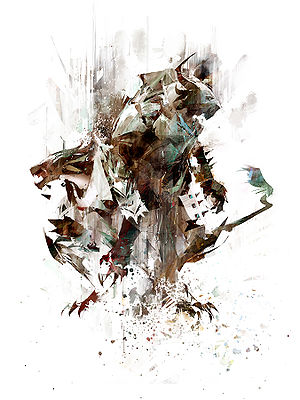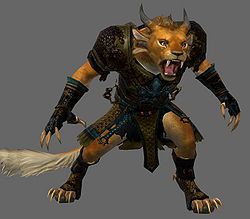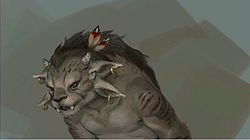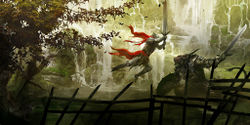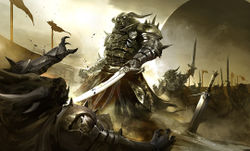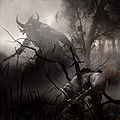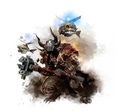Charr
“The charr race was forged in the merciless crucible of war. It is all they know. War defines them, and their quest for dominion drives them ever onward. The weakling and the fool have no place among the charr. Victory is all that matters, and it must be achieved by any means and at any cost.
— In-game description
The charr are a race of large, savage, feline creatures that occupy much of eastern Tyria. They have renounced all gods as false and instead view all of life, from magic to combat, with a hard, cynical eye. Their culture has developed into a military state where they are raised as warriors from birth.
Charr are one of the five playable races in Guild Wars 2.
Character creation[edit]
During character creation, a player can customize a charr's physical appearance and answer three race specific biography questions which affect their personal story:
- which legion they are a part of.
- who in their warband they are closest to.
- what sort of character their father was.
Selecting a charr character will start players off in the tutorial Fury of the Dead where the players fight the restless Ascalonian ghosts. After finishing the mission, they will appear in the Village of Smokestead, the starting area in the Plains of Ashford.
The charr home instance is in the Hero's Canton in the Black Citadel.
Charr racial skills reflect a war theme.
Physiology[edit]
The charr are carnivorous feline-like humanoids. They stand on their hind legs and are taller than a human by half of an average human's height, but do not have the massive bulk of the norn. They prefer a hunched pose when standing, but will on occasion stand tall and straight. When they are moving, and their paws are vacant, the charr favor in running on all four limbs with a loping gait. While the males are described as being generally stronger and the females more lithe and quick, this lore difference between sexes is not as evident in the game.
They have a short fur from head to toe in a variety of colors and patterns, many of which are similar to those of lions, cheetahs and tigers. Their fur patterns are also like that of leopards, snow leopards, and even some fur types of common housecats. Many charr have a longer mane of fur between the shoulders and on the back of the head and neck. A male charr has less fur on the tail with longer fur only on the tip, while the female's tail has longer fur from top to bottom. Charr are incapable of sweating.[1]
Their muzzle is elongated, and their mouths are filled with prominent sharp teeth suited for their carnivorous diet. Male charr have larger teeth on their bottom jaws, while females usually have considerably smaller teeth. Their heads have four horns; those from the top of the head are more prominent than those between the two sets of ears. The top pair of ears hears high frequencies or ultrasound such as a dog might, while the bottom pair hear low frequencies or infrasound similar to an elephant. However, they have difficulty hearing mid-frequency sounds such as those used in human speech, which can aggravate already tense charr-human relations.[2] Like ordinary cats, charr have six flat mammary glands hidden underneath their fur.[3]
They have a set of sharp claws, which can be used as knives for general tasks, but it appears they tend to rely more on weapons when fighting.
Charr cubs are born fully furred, with open eyes and functional limbs. Within a few days, cubs can follow their mothers over even the harshest terrain. They eat meat within a month of birth, and are fully independent several months later. The cubs mature at about the same rate as humans.[4]
Culture[edit]
The charr are primarily a military culture, and their society, technology, and relationships are very much focused on supporting war. Society is built around military units, of which charr become a part from early childhood. Non-military tasks, such as farming and trade, can be left to the young, retired, and injured. But regardless of a charr's vocation, they are always viewed as a soldier first, and view life accordingly. The weak and the foolhardy are viewed with particular contempt, and such behavior can result in becoming a gladium,[5] or in the worst case, one's name being stricken from the race's history.[6][7]
Charr on occasion mate for life, but most relationships are more casual and temporary. Biological relationships are recognized, but adult charr traditionally have very little contact with their parents or siblings,[8][9] though in recent years this has been silently changing.[10] Biological family will sometimes respond to a charr's dishonorable or contemptible action, which might reflect poorly on the entire family and its reputation.[11][12][13] As soon as a cub is weaned, at around a year of age, they enter the fahrar of one of their parents' legion. There they form their first warband, and are trained as military units under the supervision of an adult. They are considered an adult themselves once their warband no longer needs supervision by others.[8][4]
Cubs are taught to unify and define their own social structure, and each warband shares a root name, which is adopted by its members as part of their surnames. While ancestry is known and acknowledged, parents have little to do with the actual raising of a cub, and as such, the warband is viewed as a charr's family. To charr, the bonds of loyalty and connection that are formed among them during combat and duty rival those of other races' families. Though some charr leave, change or lose their warband, the strong bonds formed within it usually leave a deep impact on a charr. Individuals who want to change their warband must also change their surname and try to fit in quickly if they are to survive. However, charr occasionally choose the fate of a gladium rather than risk losing the new bonds they would otherwise form in a new warband again.[8]
When the subjugation of the female charr by the Flame Legion ended, male and female charr were once again viewed as equals. Neither sex differentiates themselves by wearing differently tailored or styled clothing.[14]
The charr are highly industrious, and are renowned and feared for their military technology, weapon development, war machines and mass production. They pioneered the creation of steam engines, choppers, and submarines.[15][16][17] Their industrial culture in the Iron Legion led to the development of the Engineer profession as well.[18] Charr have also crafted some of the finest clockwork and spring-driven devices in Tyria. Their development in technology eventually led to the invention of the printing press, which in turn propagated the widespread use of the New Krytan language.[19] While the average charr of the High Legions is willing to embrace technology, many view the use of magic as a sign of weakness, and most distrust magic-users as a whole.
Much of charr-occupied land has been repurposed to farms and fields for livestock and their feed. Cattle, sheep, warthogs, dolyaks and devourers are their primary sources of nutrition. "Meat festivals" (such as Meatoberfest) are held as a type of cultural celebration, as well.
Religion[edit]
Due to their history, many charr shun religion. They do not accept any god's authority and quickly anger on topics of charr worship or manipulation by god-like beings. Charr acknowledge other races' gods as beings of power, but do not see anything as worthy of worship. In the case of the Human Gods, the charr view the deities as beings to fight and strive to kill. At most, any reverence is limited only to great heroes of charr history and their deeds, such as Pyre Fierceshot and Kalla Scorchrazor.
Government[edit]
Charr society is built around a military chain of command that every cub is raised to respect. The de jure head of the chain of command is the Khan-Ur, considered the primus imperator. They rank above the imperators of all four legions and coordinate all the armies of the charr. There is currently no Khan-Ur because no charr holds the leadership artifact, the Claw of the Khan-Ur. The charr nation is therefore currently led by a kratocratic oligarchy consisting of leaders from the four High Legions. Each legion has a primus warband, for which the legion is named, and is led by an imperator, a descendant of the original Khan-Ur.[8] If an imperator can obtain the Claw, as well as perform a great deed, that charr may claim the title of Khan-Ur.
All four legions are fiercely protective of their independence from the others, each maintaining its own lands and city-state strongholds. Three of the High Legions—Ash, Blood and Iron—are allied, and work cooperatively toward their goal, military conquest of lands beyond those already held by charr as a race. The fourth legion, the Flame Legion, is outcast, and at civil war with the allied legions. No legion allows the others to rule them, but the Iron legion is claimed to take a leading role within Ascalon.
In times of emergency, the High Legions are known to hold defense quora, during which the highest-ranking members of the location of the emergency meet to plan a solution to whatever the emergency is—whether it be repelling an enemy or managing refugee movements.
Military ranks[edit]
The charr military has a multitude of ranks. Directly beneath each legion's imperator are its tribunes. There are rarely more than ten tribunes per legion (e.g., Iron Legion currently has six). Tribunes command an entire theater of war, or a large swath of controlled territory. One or more centurions operate under each tribune, coordinating maneuvers on a broad scale. Each centurion in turn commands a number of warbands (i.e., a "company"). When an operation includes multiple centurions, one is on occasion promoted to the temporary rank of primus centurion.
Each Warband is commanded by a legionnaire, who is assisted by a lieutenant, their second-in-command. Under the command of a lieutenant are the warbands individual soldiers, the grunts that turn the gears of war. Officers cannot officially issue orders to the soldiers of other legions, unless given permission by an officer of the legion in question. Finally, the lowest rank, and the one that no charr aspires to attain, is the gladium, the rank given to those charr who have lost their warband. These are the lowest of the low, given little if any respect or even responsibility, regardless of any former rank or honor. They are considered to have no honor, although many still have their dignity and pride. Note that merely being away from one's warband on assignment, or otherwise due to orders, is not viewed as being a gladium.
In addition to the ranks described above, there are various other, incidental ranks within the hierarchy of the High Legions command structure. These are, of course, separate from the direct chain of command:
- Chain of command ranks
- Khan-Ur
- Imperator
- Tribune
- Primus Centurion
- Centurion
- Legionnaire
- Lieutenant
- Soldier
- Special ranks
Names[edit]
Charr first names are often based on the theme of their legion (e.g., Pyre, Ember, Forge). Along with this, male names also often sound sharper, as they tend to contain more stops and fricatives: D, T, G, K; and less frequently, the liquids R and L. This phenomenon can be heard in names like Rytlock, Gron and Dinky. Female names, in contrast, usually sound smoother, and often contain sibilants. Voiced consonants are also more common. Thus feminine names are seen with the letters SH, L, S, Z, and so on. Examples of female charr names include Bathea, Kalla and Elexus. The names of both genders often start with a sharp-sounding consonant. However, as with most things, exceptions to this do exist. Some names use Roman or Greek (inspired) names as well.
As for charr surnames, these are usually of two types: Those that, like many first or given names, are borrowed or sound similar to Roman (or less commonly Greek) names, are occasionally encountered, but not as often as in the case of given/first names. The second type usually consists of two combined descriptive words, one of which denotes the bearer's warband. Examples of this are seen in Rytlock Brimstone (from the "Stone" Warband) and Scylla Rustcloud (who hails from the "Rust" Warband). Charr individuals generally decide on variations of their surnames when their first warband is formed (in a fahrar). Surnames are supposed to signify the owner's personality, ideals and/or history. The other part(s) of a charr's surname often refers to their chosen occupation. A few examples of this can be seen in the names Primus Gravepelt (Primus being an adult instructor for a fahrar) and Radarr Boommaker, whose job is to create fireworks.
Members of the same warband can also have the warband part of their name set in a different order than other members' names, though this is rare, some examples include Lightbringer Swordshatter and Legionnaire Bloodsword of the Sword Warband, and Vitus Silverpick of the Pick Warband (other Pick Warband members use Pick as their surname's prefix).
History[edit]
Khan-Urs and shaman castes[edit]
The charr were one of the modern races to spread out from their original homeland. Beginning somewhere east of the Blazeridge Mountains, the charr began as a disorganized group of warbands fighting among each other for dominance of territory. Eventually, one charr stood above the rest and claimed the title of Khan-Ur, uniting the race in the charr's first, and so far only, true golden age. Though still primitive, the charr spread into other territories, moving into the now-called Blood Legion Homelands and Ascalon, taking land from dwarf, grawl, and many other races. They would have spread further, but the Forgotten stood against them. This conflict did not last long, as the Forgotten were pulled back to the Crystal Sea for another duty. Still, though, the charr found a new barricade to their expansion: humanity.
The united charr stood a chance against the humans; however, when the Khan-Ur was assassinated without leaving any clear heir, the race fractured into the four High Legions, each led by a cub of the Khan-Ur. Several charr have since held the title of Khan-Ur; however, none have been able to unify the charr for longer than a few years, each being overthrown or dying in battle shortly after pressing their claim.[8] In this time of strife, though even just one legion could suffice, the charr held back on expanding westward through the Far Shiverpeaks, resulting in skirmishes with the norn that grew to mutual respect of strength, and a strange pseudo-alliance that remains to this day.
In time, the charr began to blame the power of the Old Gods for the humans' victories. This led the charr to seek gods to call their own, and when the Flame Legion Burnt warband encountered the titans at the volcano Hrangmer, they had found them. The Shamans of the Flame Legion decided that they would accept the magic of the titans, and when the Flame Legion returned, so, too, did the Shamans of the other Legions. The Shamans, in particular those of the Flame Legion, became a ruling caste, and before long the charr were unified once more under their banners. One charr, however, spoke out against the titans - Bathea Havocbringer. She led an underground rebellion against the Shamans, but failed and became a sacrifice to the new gods. Her actions also led to the removal of female charr from the battlefield, and being consigned to domestic duties.
Once more united, the charr finally resumed the war against the humans in 1070 AE, in a war known to humans as the Charr Invasion. They struck without warning and with a devastating new power, granted to them by the titans. Using the Cauldron of Cataclysm, they brought forth the Searing, destroying the Great Northern Wall, and invaded the three human kingdoms: Ascalon, Kryta, and Orr. Ascalon was crushed, but the newly-formed White Mantle were able to prevent the charr from taking Kryta, and the Cataclysm brought the war in Orr to an end for humans and charr alike.[8]
Renewed Wars[edit]
In 1072 AE, the titans were unleashed across Tyria due to the actions of Vizier Khilbron as part of the Flameseeker Prophecies, but were stopped and ultimately slain in front of the charr's own eyes by human heroes, King Adelbern among them. The proof that the titans were, in fact, mortal rocked charr society and caused chaos at the top of their hierarchy. Individuals and even entire warbands began breaking away from orthodoxy, and the religious establishment struggled to keep both the heretics and the humans at bay. When the Destroyers began flooding Tyria in 1078 AE, the desperate Hierophant Burntsoul attempted to put them forward as the charr's new gods, but was stopped by Pyre Fierceshot.
Despite the turmoil within the charr's own ranks, and the human Ebon Vanguard striking at them from within their own homelands, they were still able to conquer almost all of Ascalon within two decades. Without the Great Northern Wall for protection, only Ascalon City and the new stronghold of Ebonhawke far to the south remained under human control. In 1090 AE, the Flame Legion imperator of the time decided to end the war once and for all and besieged Ascalon City for days on end. Just as it looked like the charr might finally have their conquest and the Ascalonians' will would falter, King Adelbern unleashed the power of Magdaer, bringing forth the Foefire. All humans within range of the spell were killed and their spirits were bound to the land, rising up to fight the charr in spectral undeath. The ghosts persist to this day, and as long as they do, the charr will never truly hold Ascalon.
With the fall of the Flame Legion's 'gods' fresh in memory and the Foefire denying the charr any hope of victory against the humans, a rebellion against the Shamans began. Even in their weakened state the Flame Legion proved a match for the other legions, and it wasn't until Kalla Scorchrazor joined the battle with an army of female charr who had been training in secret for generations that the tides truly turned. After the Flame Legion surrendered on the Plains of Golghein, they were cast out of charr society and females regained their place alongside males. Now stronger than ever, the charr were able to turn their attention to the Ascalonian ghosts and the remaining humans.
A Fragile Peace[edit]
Since then there have been victories and reversals for both sides. The human nation is now gone from Ascalon, with the exception of the fortress city of Ebonhawke, which has been besieged for generations. By 1324 AE, a truce faction had grown among the charr. Ogres had begun to come down from the Blazeridge Mountains, seeking land for their herds, the Flame Legion stood against the three united Legions, and Ascalon was still haunted. The humans, too, had been driven back on numerous fronts, almost to the gates of Divinity's Reach itself by bandits and centaurs.
An agreement for a ceasefire and treaty negotiations was brokered by the Vigil between Divinity's Reach and the Black Citadel, the Iron Legion's capital city on the condition that the humans return the Claw of the Khan-Ur, an artifact whose ownership is a requisite to become Khan-Ur, but was lost in the Foefire. Dougal Keane was able to retrieve and return it, and now for the first time in the charr's long history it looks like peace with the humans may actually be a possibility.
Gallery[edit]
- Primary article: Category:Charr concept art
Trivia[edit]
- The charr have many similarities with two real-life ancient societies:
- The Mongols—they were once separate clans fighting amongst each other, and were united under a Khan. They also broke through an enormous wall of a southern kingdom: China in the case of the Mongols; Ascalon in that of the charr.
- The Roman Empire—many titles, words, and their modern military appears greatly inspired by the Roman Empire.
- The charr have a dieselpunk theme, as shown by the heavy machinery, combustible engines, and focus on warfare and heavy artillery.
- During development strengths and weaknesses were used to create stories for the race. The three virtues of the charr are industry, discipline, fearlessness. The three weaknesses are aggression, bloodthirst, and ruthlessness.[20]
- The male charr player character was originally voiced by Ron Yuan. In July 2016, ArenaNet announced that Lex Lang would be the new voice of the male charr player character, since Ron Yuan was unable to continue in the role for scheduling reasons.[21]
- The female charr player character was originally voiced by Kate Miller.[22] In May 2019, ArenaNet announced that Mara Junot would be the new voice of the female charr player character, since Kate Miller was unable to continue in the role for scheduling reasons.[23]
- Charr sometimes use the term "mouse" (or the plural "mice" as applicable) to refer to humans.[24]
- There is also at least one instance of "mouse-brain" used as a mild insult to an unknown individual(s).[25]
See also[edit]
| The Guild Wars Wiki has an article on Charr. |
- The Movement of the World: Charr
- The Artistic Origin of the Charr
- The Ecology of the Charr
- The Legions of the Charr
- Gallery of charr appearances
- Olmakhan
External links[edit]
- Official page, GuildWars2.com
- Charr Clothing and Female Art Direction, KristenPerryArt.com
- Charr Week promotional blogs
- Creating the Charr Starter Area, ArenaNet Blog (archived)
- Scott McGough on Writing the Charr, ArenaNet Blog (archived)
- The Artistic Origin of the Charr, ArenaNet Blog (archived)
References[edit]
- ^ Protect Port Cascadia from enemy mortar fire
- ^ [GW2]We're all waiting very, very patiently for class reveals. *twitch*, Penny Arcade forum post
- ^ Post by Martin Kernstein in "ArenaNet: The Artistic Origin of the Charr", GuildWars2Guru.com (Archived)
- ^ a b Ashenfold Cartel Interview with Jeff Grubb and Eric Flannum!, The Ashenfold Cartel
- ^ Vere the Coward
- ^ Lore Interview with Jeff Grubb in GuildMag Issue 5, GuildMag.com
- ^ "Chapter 21", Ghosts of Ascalon by Jeff Grubb and Matt Forbeck:
- "The human tales never mention his name, other than the imperator of the Flame Legion."
- Ember nodded. "I do not know. After his disgrace, his name was stricken from our records."
- ^ a b c d e f The Ecology of the Charr
- ^ The Legions of the Charr
- ^ Primus Sparbreaker
- ^ Ferro the Butcher
- ^ AWOL
- ^ Searching for the Truth
- ^ Post by Regina Buenaobra in "ArenaNet: The Artistic Origin of the Charr", GuildWars2Guru.com (Archived)
- ^ Sea of Sorrows
- ^ Kailani the Foolhardy
- ^ Legionnaire Burnwhite
- ^ Guild Wars 2: Engineer - Interview mit Eric Flannum und Jon Peters (english), Wartower.de (archived)
- ^ Cultural Diffusion in Contemporary Kryta
- ^ Scott McGough on Writing the Charr, Arena.Net (Archived)
- ^ Meet the New Voice of the Male Charr Player Character, GuildWars2.com
- ^ Guild Wars 2 (2012) at IMDb.com
- ^ Meet the New Voice of the Female Charr Player Character, GuildWars2.com
- ^ Special:Search/"mouse" "dialogue"
- ^ Corrcus Vengefur (Dodge Instructor)
- Corrcus Vengefur: Over there's a chest full of... something. Something I want. But some mouse-brain surrounded it with mines!
